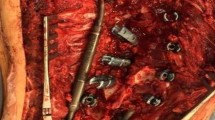Abstract
The aim of this study was to investigate the feasibility and clinical efficacy of treatment of adolescent idiopathic scoliosis of >100° via posterior-only surgery with strong halo-femoral traction and posterior wide release. From December 2003 to August 2006, 121 patients with adolescent idiopathic scoliosis were treated in our hospital; among them, 29 patients with curves over 100° were included in this study. From December 2003 to June 2005, group A included the first 12 patients who underwent combined anterior release followed by two-week halo-femoral traction and then posterior instrumentation. From July 2005 to August 2006, 17 patients in group B underwent posterior surgery alone with strong halo-femoral traction and posterior wide release. All of the patients were followed-up for a minimum of 31 months (mean, 36 months; range, 31–41 months). There were no severe complications. All of the patients achieved bony fusion without instrumentation breakage or pseudarthrosis. There were no statistically significant differences between the two groups in gender, age, type of adolescent idiopathic scoliosis, preoperative coronal major curve values, major curve flexibility, or final follow-up major curve correction rate. The average operative time, blood loss and hospital stay in group B were less than those in group A. In adolescent idiopathic scoliosis with Cobb >100°, posterior-only surgery with strong halo-femoral traction and posterior wide release can provide comparable curve correction with shorter operative time, less blood loss and shorter hospital stay when compared to combined anteroposterior surgery.

Similar content being viewed by others
References
Qiu Y, Zhu LH, Lv JY et al (2001) Surgical strategy and correction technique for scoliosis of more than 90°. Chin J Surg 39:102–105
Li M, Liu Y, Zhu XD et al (2004) Surgical results of one stage anterior release and posterior correction for treatment of severe scoliosis. Chin J Orthop (Chin) 24:271–275
Newton PO, Wenger DR, Mubarak SJ et al (1997) Anterior release and fusion in pediatric spinal deformity. A comparison of early outcome and cost of thoracoscopic and open thoracotomy approaches. Spine 22:1398–1406
King A, Mills T, Loe WA Jr et al (2000) Video-assisted thoracoscopic surgery in the prone position. Spine 25:2403–2406
Niemeyer T, Freeman F, Grevitt et al (2000) Anterior thoracoscopic surgery followed by posterior instrumentation and fusion in spinal deformity. Eur Spine J 9:499–504
Dobbs MB, Lenke LG, Kim YJ et al (2006) Anterior/posterior spinal instrumentation versus posterior instrumentation alone for the treatment of adolescent idiopathic scoliotic curves more than 90°. Spine 31:2386–2391
Suk SI, Lee CK, Kim WJ et al (1995) Segmental pedicle screw fixation in the treatment of thoracic idiopathic scoliosis. Spine 20:1399–1405
Liljenqvist U, Lepsien U, Hackenberg L et al (2002) Comparative analysis of pedicle screw and hook instrumentation in posterior correction and fusion of idiopathic thoracic scoliosis. Eur Spine J 11:336–343
Burton DC, Andrew AS, Marc AA et al (2005) The treatment of large (>70°) thoracic idiopathic scoliosis curves with posterior instrumentation and arthrodesis: when is anterior release indicated. Spine 17:1979–1984
Zhang HQ, Lu SJ, Chen J et al (2007) Treatment of severe idiopathic scoliosis with wide posterior spinal release and 3D spinal correction. Chin J Spine Spinal Cord 17:274–279
Lenke LG, Betz RR, Harms J et al (2001) Adolescent idiopathic scoliosis: a new classification to determine extent of spinal arthrodesis. J Bone Joint Surg(Am) 83:1169–1181
Kim YJ, Lenke LG, Bridwell KH et al (2005) Pulmonary function in adolescent idiopathic scoliosis relative to the surgical procedure. J Bone Joint Surg Am 87:1534–1541
Lenke LG, Newton PO, Marks MC et al (2004) Prospective pulmonary function comparison of open versus endoscopic anterior fusion combined with posterior fusion in adolescent idiopathic scoliosis. Spine 29:2055–2060
Vendantam R, Lenke LG, Bridwell KH et al (2000) A prospective evaluation of pulmonary function in patients with adolescent idiopathic scoliosis relative to the surgical approach used for spinal arthrodesis. Spine 25:82–90
Halm H, Niemeyer T, Link T et al (2000) Segmental pedicle screw instrumentation in idiopathic thoracolumbar and lumbar scoliosis. Eur Spine J 9:191–197
Acknowledgments
The study was supported by the Hunan Province Institute of Science and Technology (06SK3015) and the Health Department of Hunan Province of Scientific Researching Fund (B2006040). The authors have no conflicts of interest to declare.
Author information
Authors and Affiliations
Corresponding author
Rights and permissions
About this article
Cite this article
Zhang, Hq., Wang, Yx., Guo, Cf. et al. Posterior-only surgery with strong halo-femoral traction for the treatment of adolescent idiopathic scoliotic curves more than 100°. International Orthopaedics (SICOT) 35, 1037–1042 (2011). https://doi.org/10.1007/s00264-010-1111-8
Received:
Revised:
Accepted:
Published:
Issue Date:
DOI: https://doi.org/10.1007/s00264-010-1111-8




